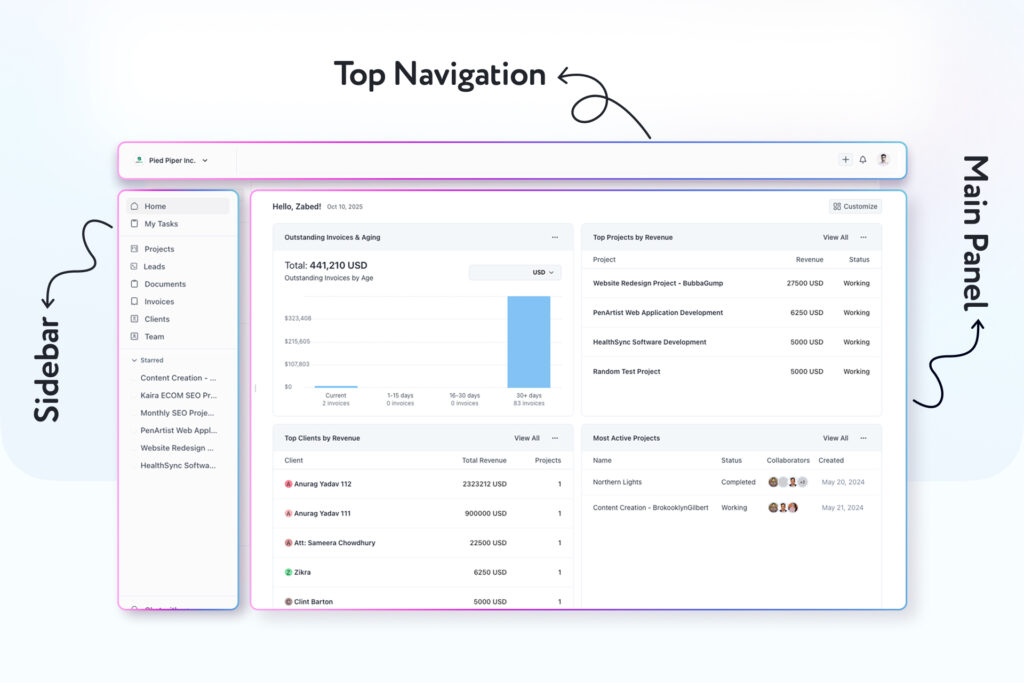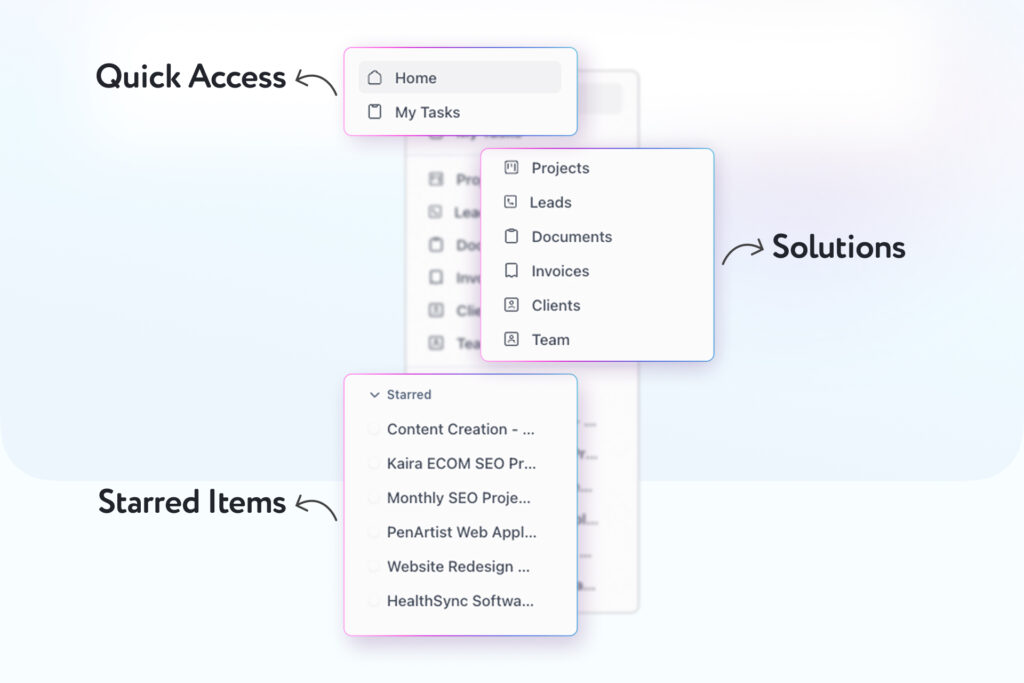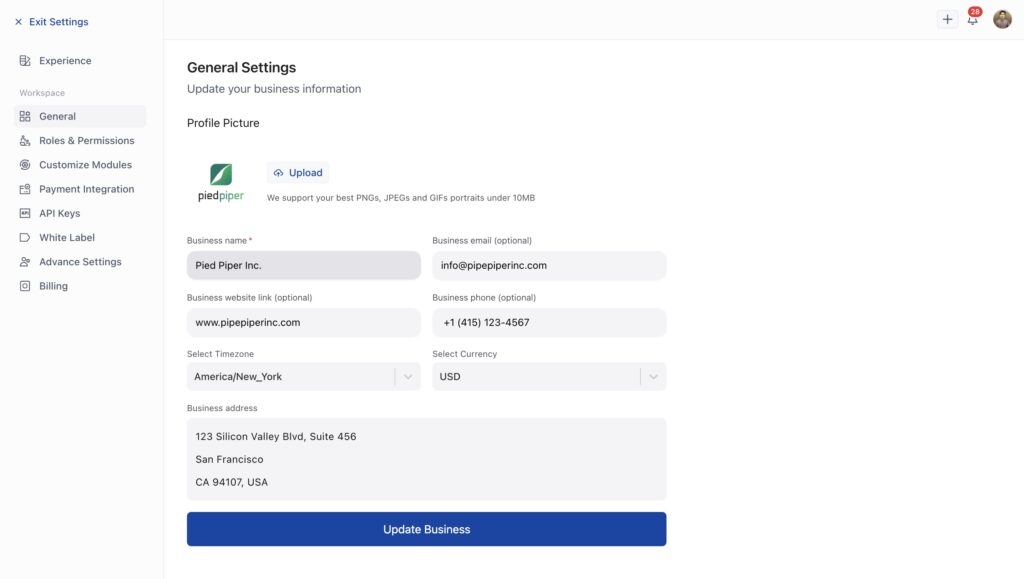OneSuite is designed to be intuitive, but knowing where everything is helps you work faster. This guide walks you through the interface so you can navigate confidently and find what you need without hunting.
In this guide, we discussed:
- How the OneSuite interface is organized
- What’s in the top navigation and how to use it
- How to navigate with the sidebar
- Where to find modules, records, and settings
- Keyboard shortcuts to work faster
- How to search and use quick actions
Interface Overview #
The OneSuite workspace is divided into three main areas: the top navigation, the sidebar, and the main panel.
- Top Navigation – Holds your profile, notifications, and quick create actions
- Sidebar – Your navigation hub for accessing solutions, records, and starred items
- Main Panel – Where your work happens and data displays

Understanding these three areas helps you move around OneSuite efficiently.
Top Navigation #
The top navigation bar runs across the top of every screen in OneSuite. It contains tools you’ll use constantly throughout your day.
Business Switcher (Left Side) #
What it shows:
The name of your current business.
What you can do:
- See which business you’re currently working in.
- Click the dropdown arrow to switch between businesses if you manage multiple agencies.
Example:
If you run two agencies or have separate test and production environments, click the business name to switch between them.
Quick Create Button #
The + icon lets you create records instantly from anywhere:
- Add Lead – Create a new lead in CRM
- Create Project – Start a new project
- Add Client – Add a client directly
- Create Proposal – Build a new proposal or contract
- Invite Member – Add a team member to your business
Why it matters:
You don’t need to navigate to a specific solution first. Click + from any screen, choose what you want to create, and you’re there.
Example:
You’re reviewing Dashboard and remember you need to send a proposal. Click +, select Create Proposal, and you’re in the document builder without navigating through menus.
Notifications (Right Side) #
The bell icon shows alerts about your business.
What you can do:
- Click the bell to see all notifications
- See the red badge showing how many unread notifications you have
- Click individual notifications to jump directly to that record
Example:
The notification badge shows “1” in red. You click and see a client just paid an invoice. Click the notification and jump directly to that invoice record.
Profile Menu (Far Right) #
Your profile picture and account access:
What you can do:
- Access your personal profile settings
- Get support (clicking it opens the live chat box).
- Sign out of OneSuite
Sidebar #
The sidebar is your navigation hub. It lives on the left side of the screen and gives you access to everything in OneSuite. The sidebar has four distinct sections from top to bottom.

Section 1: Quick Access (Top) #
This section appears at the very top of the sidebar and provides instant access to your most important views.
Home
Your Dashboard view. Click this from anywhere to return to your command center with business metrics and activity.
My Tasks
Your personal task list. Shows every task assigned to you across all projects in one consolidated view. Your go-to spot for knowing what’s on your plate.
Why are these at the top:
Home and My Tasks are where most people start and return to throughout the day. Quick access means fewer clicks.
Section 2: Main Navigation (Solutions) #
This is the largest section of the sidebar and contains all six core solutions. Each solution has its own icon and label.
The six solutions you’ll see:
Projects
Organize and deliver client work. Access all projects, create new ones, view tasks.
Leads
Your CRM for managing potential clients. Add leads, track pipeline, convert to clients.
Proposals & Contracts
Create proposals, contracts, and agreements. Send for signatures, track status.
Invoices
Bill clients and collect payments. Create invoices, track payments, and manage recurring billing.
Clients
Your relationship hub. View all clients, access complete history, and manage contacts.
Team
Manage your people. Add members, set permissions.
How to navigate:
Click any solution name to open it in the main panel. The currently active solution appears highlighted so you always know where you are.
Example:
Click Projects to see all your projects. Click Invoices to switch to billing. Click Clients to view client relationships. Each click takes you to that solution’s main view.
Section 3: Starred Items #
This section appears below the main solutions and shows your starred records for quick access.
What you can star:
Any record you access frequently like important projects you’re actively managing
Section 4: Bottom Actions #
The bottom of the sidebar contains support and configuration tools.
Chat with us
Access support directly from OneSuite. Click to start a conversation with the support team for help with any questions.
Settings
Your control room. Click to access all business configuration, team management, integrations, and customization options.
Why these are at the bottom:
You don’t use these as frequently as solutions or daily tasks, but you need them accessible when you do. Bottom placement keeps them available without cluttering your main navigation.
Main Panel #
The main panel is the large area to the right of the sidebar. This is where your actual work happens and where all your data displays.
What Appears in the Main Panel #
Depending on what you’re viewing, the main panel shows:
Dashboard view (when Home is selected):
- Business metrics and widgets
- Recently completed tasks
- Most active projects
- Overdue tasks
- Upcoming deadlines
Solution views (when a solution is selected):
- Lists of records (all leads, all projects, all invoices)
- Individual record details
- Forms for creating new records
- Edit interfaces for updating data
Settings views (when Settings is selected):
- Configuration pages
- Team management
- Integration setup
- Customization options
Common Navigation Patterns #
Here are the most common ways you’ll move around OneSuite during your day.
Starting Your Day
- Log in → Lands on Dashboard (Home)
- Check notifications (bell icon) for overnight activity
- Click My Tasks to see what’s on your plate today
- Click a specific project or solution to start working
Settings Access #
Settings appears in the bottom of the sidebar and is your gateway to configuring OneSuite.

What Settings Includes #
When you click Settings, the main panel shows:
Workspace section:
- General – Business name, logo, address, timezone, currency
- Roles & Permissions – Control who can access what
- Customize Solutions – Add custom fields, change pipeline stages
- Payment Integration – Connect Stripe, PayPal, RazorPay, QuickPay
- API Keys – Access for integrations and developers
- White Label – Custom domain and branding for Client Portal
- Advance Settings – Technical configuration options
- Billing – Subscription and payment information
Experience section:
- Personal preferences
- Notification settings
- Display options
Settings Navigation #
Settings has its own sidebar navigation:
When you click Settings in the main sidebar, a secondary sidebar appears showing all settings categories. Click any category to view its options in the main panel.
Example from screenshot:
Settings sidebar shows: Experience, General, Roles & Permissions, Customize Solutions, Payment Integration, API Keys, White Label, Advance Settings, and Billing.
Clicking General displays business information fields like business name, email, website, phone, timezone, currency, and address.
Getting Back from Settings #
To exit Settings and return to your solutions:
- Click Exit Settings in the top left corner
- Or click any solution in the main sidebar (Projects, Leads, etc.)
Common Navigation Questions #
How do I know which solution I’m currently in?
The active solution appears highlighted in the sidebar. You’ll also see the solution name in the main panel header.
What if I can’t find a solution in the sidebar?
If you don’t see a solution, check your permissions in Team or ask your admin. Some solutions may be restricted based on your role.
Q: Can I open multiple records at once?
A: OneSuite is single-panel focused. Open one record at a time. Use browser tabs if you need multiple views open simultaneously.